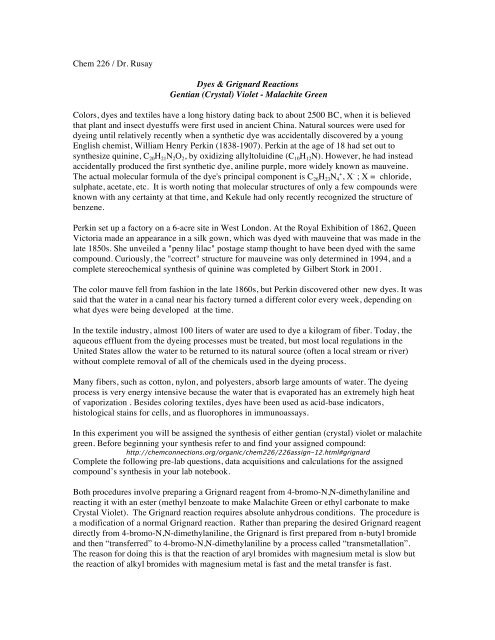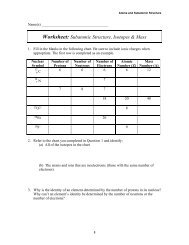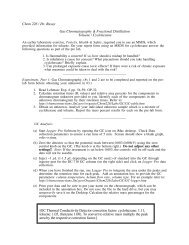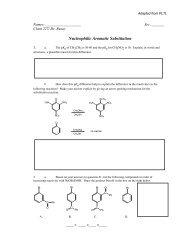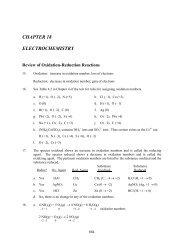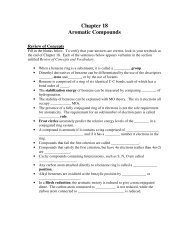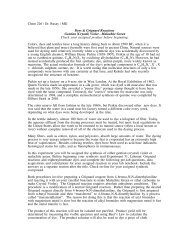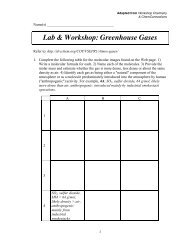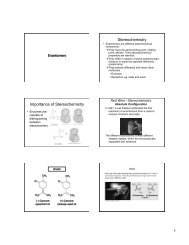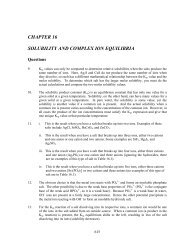Grignard Reaction - ChemConnections
Grignard Reaction - ChemConnections
Grignard Reaction - ChemConnections
Create successful ePaper yourself
Turn your PDF publications into a flip-book with our unique Google optimized e-Paper software.
The product of this reaction will not be isolated or purified. Product yield will be determined bymeasuring the visible spectrum and using Beer’s Law to calculate the concentration of dye. Theproduct solution will also be used to dye a piece of cloth.+Mg CH 3CH 2CH 2CH 2BrCH 3CH 2CH 2CH 2Br + MgC 25H 30N 3ClGentian Violet(magenta dye)1) n-butyl Mg2) ethylcarbonateC H 3NCH 31) n-butyl Mg2) methylbenzoateC 23H 25N 2ClMalachite Green(blue-green dye)BrPre-lab Questions: (Include the following in your lab Notebook. Follow the standard reportformat: some of the answers to the questions will be part of your write-up (Data Table: #1 and#2; and #3 and #4. Check your assigned product before beginning. )1) Using a reference, find the exact structure, molecular formula and molecular weight for yourproduct.2) Find the assigned product's MSDS and consider if it is toxic. If so, how toxic do you think itis?3) Write balanced equations for each of the 4 steps of your reaction:a) formation of the n-butyl bromide <strong>Grignard</strong> reagentb) transmetallation reactionc) reaction of <strong>Grignard</strong> reagent with esterd) reaction with HCle) What is the stoichiometry of the aniline relative to the ester in your reaction?4) Normally, an alcohol can be isolated from the reaction of an ester with a <strong>Grignard</strong> reagent,but in this case the elimination product readily forms at room temperature without heating.The structure of the product is positively charged, having a chloride ion as a counter ion (ananion). Provide a brief explanation for this effect and draw a resonance form of the productwhere one of the nitrogen atoms has a formal charge of +1 and another resonance form whereall of the nitrogen atoms respectively have a formal charge of zero.Prelab equipment preparation:Fill your drying tube with fresh (blue) Drierite. Empty the old (pink) Drierite into the usedDrierite bottle).It is essential that all apparatus used during this reaction (until the point where the mixture isadded to aqueous HCl) be clean and scrupulously dried. Clean the following glassware the daybefore you plan to do this lab:10 mL pear flask glass stirring rodreflux condensorthermometer adapter (with rubber part removed)
SAFETYCaution: Tetrahydrofuran is extremely flammable and may be harmful if inhaled. Use in fumehoods. Keep away from flames or hot plates, heat guns, or other hot surfaces.Magnesium can cause dangerous fires if ignited. Keep away from flames and hot surfaces.Caution: Crystal violet and malachite green both stain readily and are somewhat toxic. Byproductsfrom the preparation are of unknown toxicity. Avoid contact of the prepared dyes withskin and clothing. Wear gloves when handling the products. Do NOT repeatedly handle the dyedfabric.PROCEDURE:Reagent amounts below are given for the preparation of malachite green. For crystal violet(CV), use the amounts listed in parentheses. One reagent is different for crystal violet.1. Attach a reflux condensor to the top of a 10 mL pear flask. Use a utility clamp to hold thecondenser in place and a microclamp to hold the pear flask (use metal clamps if you can - plasticclamps will burn when you dry them!). Using a heat gun, heat your flask and condenser until alltraces of water vapor are gone. When finished, immediately add a drying to the top of thecondenser. Cool to room temperature.2. Weigh out 0.080 g (0.120 g for CV) of magnesium ribbon and 0.500 g (0.750 g for CV) of 4-bromo-N,N-dimethylaniline (use small weighing boats). Cut the magnesium ribbon into smallpieces to expose fresh surfaces, which will help to speed up your reaction. When your pear flaskis cool, remove it from the condenser and quickly add a stir bar and these solid reagents. Thelonger you leave the flask open to air, the more water vapor will get into your flask! Quicklyreattach your flask to the condenser.3. Use the provided syringes to measure into the glass vial: 0.40 mL (0.60 mL for CV) of n-butylbromide and 1 mL (1.5 mL for CV) of tetrahydrofuran (THF). Cap this vial to keep out water!Add this n-butyl bromide/THF mixture to the reaction flask in the same way that you added thesolid reagents.4. Begin agitation of the stir bar using the stir motor. Gently heat the reaction. The THF will startto boil (look for bubbling), indicating the beginning of the reaction. For this particular <strong>Grignard</strong>reaction, the initiation of <strong>Grignard</strong> formation is also often accompanied by a transient, red, blue,or dark-green color. Allow the reaction to continue to reflux for at least 30 minutes. The solutionshould be cloudy, perhaps yellowish-gray, and the magnesium should be almost gone.4. Let the mixture cool to room temperature. Use the provided syringes to put into the glass vial:78 microliters of methyl benzoate for malachite green (76 microliters of diethylcarbonate forcrystal violet) and 0.5 mL (0.5 mL for CV) of THF. Add this to the reaction mixture and let thereaction proceed at reflux for at least 15 minutes, warming the reaction gently.5. Cool the mixture in ice. Remove the stirbar before adding HCl so that you do not stain thestirbar with your dye. Obtain 2.0 mL of 10% aqueous HCl. Remove the condenser from thereaction setup and add this acid drop wise directly into the pear flask to form your dye. Stir themixture with a stirring rod. DO NOT use additional 10% HCl.Caution: Avoid contact with skin and clothing. After completing Step #7, DO NOTrepeatedly handle the dyed fabric ribbon.
6. Transfer the liquid to a graduated cylinder, rinsing any liquid, especially drops of organiclayer, with distilled water. Dilute to a total volume of 25.0 mL (Record the exact volume youdiluted to). Save about half of this solution in a vial for the analysis. The other half will be usedfor dyeing the cloth.7. Cloth dying: Immerse a strip of multi-fiber ribbon in the remaining mixture for at least oneminute. Remove and rinse the ribbon under running water. Blot dry. Record what you see inyour notebook. Which fabrics dyed the brightest? The weakest? If you have a camera handy,you might want to take a picture. Leave the ribbon in your drawer to dry.THIS IS THE FIRST GOOD STOPPING POINT IN THE EXPERIMENT.SPECTRUM AND YIELD:In order to determine a percent yield for this reaction, the amount of dye in the final solution mustbe determined. Because this dye is so colorful, its absorbance of visible light can be measured,and its concentration can be determined using Beer's Law. (See the respective Beer’s Law plot foryour product.)A= εbc A = absorbance measured (no units)ε = molar extinction coefficient for the dye (L/mol·cm)b = cell path length (1.00 cm)c = concentration (mol/L)Literature reference values for molar extinction coefficients in aqueous solution are:Malachite Green: 148900 M -1 cm -1 (measured at 616.5 nm) (reference 1)Crystal Violet: 92700 M -1 cm -1 (measured at 590 nm) (reference 2)Experimental Beer’s Law Plots:Gentian (Crystal) VioletMalachite Green!1.00000.90000.80000.50!Absorbance0.70000.60000.50000.4000Series1Linear (Series1)y = 89137x - 0.0168Absorbance!0.40!0.30!0.20!y = 1188.4x + 0.1121!R" = 0.99767!y = 1787.2x!R" = 0.47352!Series1!Linear (Series1)!Linear (Series1)!0.3000R 2 = 0.99930.10!0.20000.10000.00000.00!0.00E+00!5.00E-05! 1.00E-04! 1.50E-04! 2.00E-04! 2.50E-04! 3.00E-04!0.0E+00 2.0E-06 4.0E-06 6.0E-06 8.0E-06 1.0E-05 1.2E-05Molarity!MolarityDilution:1. You will be using a portion of your 25.0 mL of product solution for the analysis. If yoursolution is cloudy, before beginning the dilution shake your sample thoroughly and place enoughin a centrifuge tube to fill it about ¾ full. Centrifuge. Remove the liquid from any precipitateand save the liquid in a vial to use for dilution.2. Use pipets and volumetric flasks to dilute the solution. Keep track in your notebook of alldilutions made. Unless your solution looks much paler in color than that belonging to otherpeople, start by diluting:For malachite green: Dilute 5.00 mL of your centrifuged product solution to 250.0 mLFor crystal violet: Dilute 5.00 mL of your centrifuged product solution to 100.0 mL
Obtaining a UV Spectrum on the visible spectrophotometer3. Next to “Method” above the spectrum window is a green box that should say eitherCVIOLET.M or MALGREEN.M. If the one showing is not what you want, go to the File menuand click Load Method to select the one you want.4. Rinse a plastic cuvette with some of your sample before using, and then fill the cuvette about2/3 full with your sample. Place it in an open compartment on the spectrophotometer.5. Run the blank (water) first in compartment 1. Then click the screen for the compartmentholding the sample and run the sample. Record the absorbance reading at the appropriatewavelength (616.5 nm for Malachite Green; 590 nm for Crystal Violet).6. An acceptable absorbance reading is between 0.5 and 1. If your sample is NOT in this range,you will need to prepare a different concentration and then rerun the spectrum. If your sample'sabsorbance reading is in the correct range, print the spectrum.7. When finished, dispose of your sample and immediately rinse the cuvette thoroughly withdeionized water. Do not use organic solvents on the plastic cuvettes.References:1. F. J. Green, The Sigma-Aldrich Handbook of Stains, Dyes and Indicators, Aldrich Chem.Comp., 1990.(listed at: http://omlc.ogi.edu/spectra/PhotochemCAD/html/malachiteGreen.html)2. International critical tables. Vol VII. McGraw-Hill, New York.(listed at http://article.pubs.nrc-cnrc.gc.ca/RPAS/rpv?hm=HInit&afpf=v86-050.pdf&journal=cjc&volume=64This experiment was originally reported by D. F. Taber, R. P. Meagley, and D. Supplee. J. Chem.Ed. 73, 1996, 259. The modification using transmetallation was reported by C. Seto and J. Bairdat Brown University; http://www.chem.brown.edu/chem35/ Lab2004/Make-upLab-<strong>Grignard</strong>.pdfFurther adaptations by J. Ruehl, K. Long, R. Rusay, T. Young, R. Chamberlain. Latest revision2012.
NOTESAt a pH of ~7, the experimental spectra of malachite green and crystal violet should look similarto those shown below.Malachite GreenCrystal VioletBoth compounds can be used as dyes in addition to being used as pH indicators, which changecolor with changes in pH. Both dyes are yellow at pH ~2 or lower.If the procedure were followed exactly, the pH is ~ 7 and the products are in the correct form. Ifextra acid or added base were added, the spectrum does not look like the one shown above, andthe pH may need to be adjusted slightly. Be slow and careful in adjusting the pH. Do not getthe solution strongly acidic or basic, or the color may disappear. It may come back if you add theopposite reagent and stir for 30-45 min.Since the sample solutions include everything in the final unpurified <strong>Grignard</strong> reaction mixture,slight differences from these spectra you may be observed. The percent yield determined usingthis colorimetric procedure must therefore be considered approximate.The standard Beer’s law curve for Malachite Green (MG) should go through the origin such asCrystal Violet’s, which is why two stra ight lines are plotted for MG. The non-origin curve has amuch higher confidence level and is included for comparison. The dye is pH sensitive and theabsorbance of the reaction solution may be up to 10-12% lower than that of the neutral standardsolution, pH ≅ 7. Consider this in answering your Post lab Questions. Also, as noted above, theAcid-Base rate of reaction for pH adjustment of the product mixture is not instantaneous and canbe quite slow.______________________________________________________________________See the Chem 226 Calendar & Assignment Webpages for the Post Lab Questions


